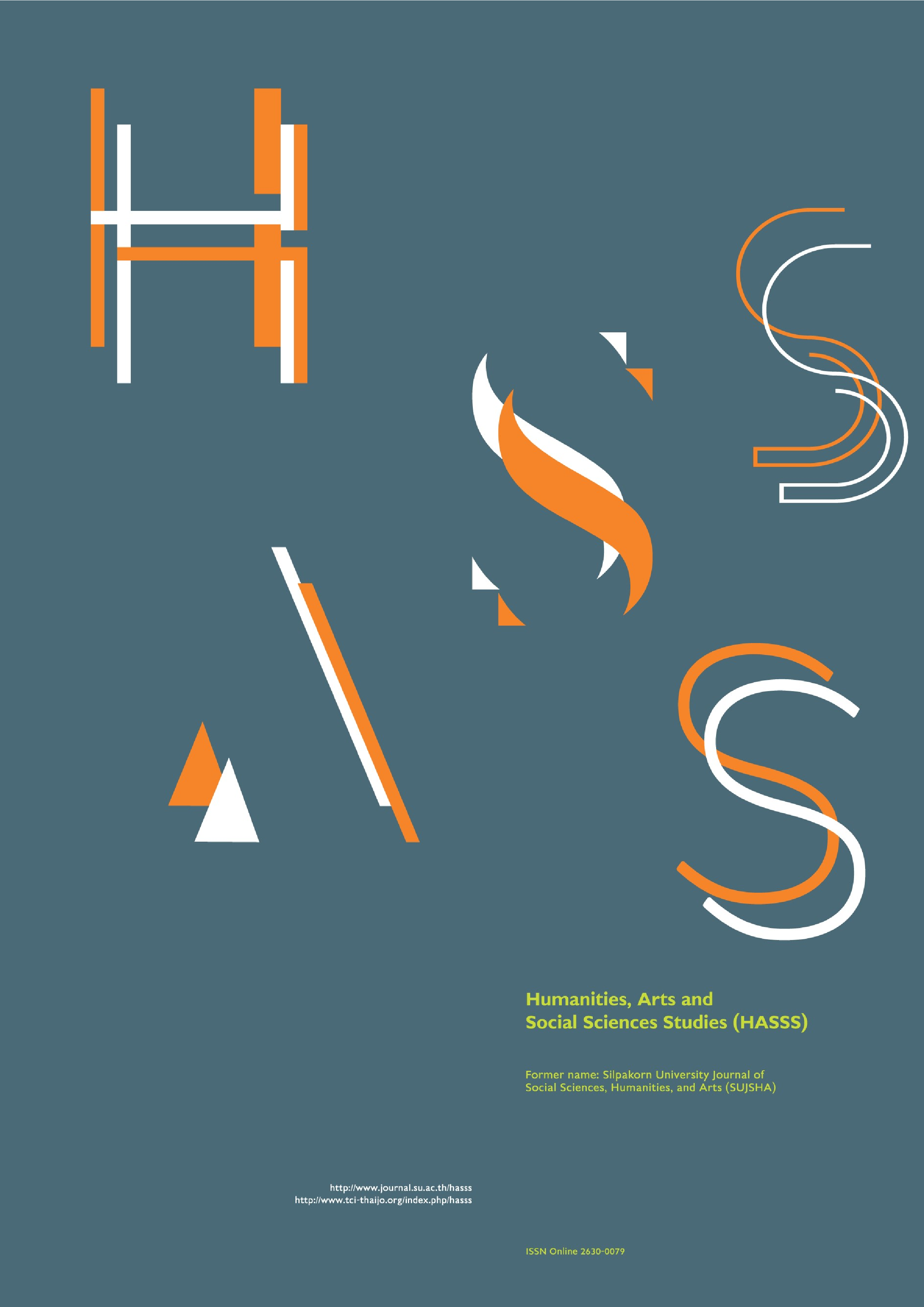From online information seeking to native advertising exposure: Examining the Thai millennials on online information cues, ad click-through and brand awareness
Main Article Content
Abstract
Three types of native advertising were examined: paid search units, in-feed units, and recommendation widgets. Online information seeking behaviors, online information cues recognition, and native advertising click-through behaviors of Thai millennials were investigated. Qualitative research was conducted. Methodological triangulation was used to compare data from in-depth interviews, observations, and coding sheets. Online information cues can be classified into two main categories: disclosure language and advertising executions. Participants recognized both categories as online information cues. Advertising executions were more remarkable when compared to disclosure languages. The advertising images used by in-feed units and recommendation widgets were product/service images, brand presenters, and brand name and logo. Text messages that participants frequently received featured all three types of native advertising. Participants pointed out that text messages of native advertising were persuasive, impulsive, and used straightforward selling messages. Advertising images and text messages were used to induce participants’ click-through behaviors and buying decisions. Recommendation widgets were the first type of native advertising that participants did not want to click through. Paid search units came in second place and in-feed units came in third place. Most participants knew the brands before being exposed to the click-through native advertising. Their intentions directed their online information seeking, communicating, product/service searching and buying. Without consumers own intentions, the opportunity of native advertising click through is hard to happen.
Downloads
Article Details

This work is licensed under a Creative Commons Attribution-NonCommercial-NoDerivatives 4.0 International License.
All rights reserved. Apart from citations for the purposes of research, private study, or criticism and review,no part of this publication may be reproduced, stored or transmitted in any other form without prior written permission by the publisher.
References
Bruce, H. (1999). Perceptions of the Internet: what people think when they search the Internet for information. Internet Research 9(3): 187-199.
Cho, C.-H. and Cheon, H. J. (2004). Why do people avoid advertising on the internet. Journal of Advertising 33(4): 89-97.
Delter, B., Sproule, S. and Cupta, C. (2003). Pre-Purchase Online Information Seeking: Search Versus Browse. Journal of Electronic Commerce Research 4(2): 72-84.
Dutta, C. B. and Das, K. D. (2017). What drives consumers' online information search behavior? Evidence from England. Journal of Retailing and Consumer Services 35: 36-45.
Einstein, M. (2017). Advertising: What Everyone Needs to Know. New York: Oxford University Press.
Elliott, M. T. and Speck, P. S. (1998). Consumer perception of advertising clutter and its impact across various media. Journal of Advertising Research 38: 29-30.
eMarketer. (2017). eMarketer Unveils Estimates for Native Ad Spending. [Online URL: https://www.emarketer.com/Article/eMarketer-Unveils-Estimates-Native-Ad-Spending/1015457?ecid=NL1001] accessed on February 26, 2018.
Federal Trade Commission. (2013). Com Disclosures: How to Make Effective Disclosures in Digital Advertising. (F. T. Commission, Producer). [Online URL: https://www.ftc.gov/tips-advice/business-center/guidance/com-disclosures-how-make-effective-disclosures-digital] accessed on February 19, 2018.
Katz, H. (2019). The Media Handbook: A Complete Guide to Advertising Media Selection, Planning, Research, and Buying. 7th ed. New York: Taylor & Fransis.
Knobloch-Westerwick, S. (2015). Choice and Preference in Media Use: Advances in Selective-Exposure Theory and Research. New York: Routledge.
Knobloch-Westerwick, S., Westerwick, A. and Johnson, B. (2015). Selective Exposure in the Communication Technology Context. In The Handbook of the Psychology of Communication Technology, edited by S. Sundar, pp. 407-424. West Sussex: John Wiley & Sons, Inc.
Kristiansen, P. (2017). IAB’s Clare O’Brien: We Need Algorithms for Quality Measures. [Online URL: https://nativeadvertisinginstitute.com/blog/measure-native-ad-campaign-effectiveness] accessed on February 2, 2018.
Li, Y. (2019). User perception affects search engine advertising avoidance: moderating role of user characteristics. Social Behavior and Personality: An International Journal 47(4): 1-12.
Marchionini, G. (1995). Information Seeking in Electronic Environments. New York: Cambridge University Press.
Marks, L. J., Grimm, E. P. and Campbell, C. (2019). A Review of Native Advertising. In Advertising Theory, edited by S. R. Thorson, S. Rodgers and E. Thorson, 2nd ed., pp. 484-485. New York: Routledge.
Lareau, L. M. and Miczo, N. (2017). Exploring the relationship between online health information seeking motivations and patient narratives for orthopaedic practice web sites. Ohio Communication Journal 55: 131-145.
Nabi, L. R. and Oliver, M. B. (2010). Mass Media Effects. In The Handbook of Communication Science, edited by R. C. Berger, E. M. Roloff and R. D. Roskos-Ewoldsen, 2nd ed., p. 261. Thousand Oaks: Sage.
Outbrain. (n.d.). Native Adertising. [Online URL: https://www.outbrain.com/native-advertising/] accessed on February, 2019.
Pulizzi, J. (2015). Native Advertising Is Not Content Marketing. [Online URL: https://contentmarketinginstitute.com/2015/08/native-advertising-content-marketing/] accessed on February 19, 2020.
Taboola. (n.d.). Native Advertising: Discover How to reach Your Goals with Native Advertising. [Online URL: https://www.taboola.com/native-advertising] accessed on February 22, 2020.
Think with Google. (2017). Ad Attention Research: Effectiveness Hinges on More Than Just Reach. [Online URL: https://www.thinkwithgoogle.com/intl/en-cee/insights-trends/research-data/ad-attention-research-effectiveness-hinges-more-just-reach/] accessed on February 14, 2020.
Tucci, G. (2007). Challenging tasks for 'triangulation'. International Journal of Transport Economics 34(3): 307-317. [Online URL: https://www.jstor.org/stable/42747827] accessed on February 14, 2020.
Wang, R., Balkanski, Y., Boucher, O., Ciais, P., Schuster, G. L., Chevallier, F., and Tao, S. (2016). Estimation of global black carbon direct radiative forcing and its uncertainty constrained by observations. Journal of Geophysical Research Atmospheres 121(10): 5948-5971.
Wang, P., Xiong, G. and Yang, J. (2019). Serial Position Effects on Native Advertising Effectiveness: Differential Results Across Publisher and Advertiser Metrics. Journal of Marketing 83(2): 82-97.
Wojdynski, B.W. (2016). Native Advertising: Engagement, Deception, and Implications for Theory. In The New Advertising: Branding, Content and Consumer Relationships in a Data-Driven Social Media Era, edited by R. Brown, V. K. Jones, and B. M., pp. 203-236. Santa Barbara, CA: Praeger/ABC Clio.
Wojdynski, B. W. and Golan, G. J. (2016). Native advertising and the future of mass communication. American Behavioral Scientist 60(12): 1403-1407.
Wu, M., Huang, Y., Li, R., Bortree, D. S., Yang, F., Xiao, A., and Wang, R. (2016). A tale of two sources in native advertising: examining the effects of source credibility and priming on content, organizations, and media evaluation. American Behavioral Scientist 60(12): 1492-1509.

